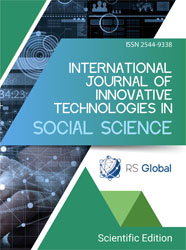SUSTAINABLE DEVELOPMENT AND TOURISM OF URBAN HERITAGE: AN IMPERATIVE FOR THE FUTURE. CASE OF DACHRA HAMRA IN EL KANTARA, BISKRA, ALGERIA
Abstract
In Algeria, as in the rest of the world, urban heritage, specifically historical centers, attracts many visitors due to their heritage significance. However, the growth of tourist flows and the attractiveness of these cities are dependent on the conservation, enhancement, and sustainable preservation of this heritage.
The original core of the city of El Kantara in Biskra, Algeria, Dachra El Hamra, remains inhabited and is distinguished by its unique architecture and urban organization. This village is regarded as a cultural model of great value. From a tourist perspective, Dachra El Hamra holds particular interest as both tangible and intangible heritage. This interest is heightened by its integration within lush landscapes, characterized by date palm orchards thriving at the foot of its majestic cliffs and impressive gorges.
The village of Dachra El Hamra remains at the center of concerns for local authorities and communities. The objective of this study revolves around this urban heritage, considering the criteria of sustainable development while promoting local and international tourism. To achieve this, we developed an evaluation using the RST02 grid, supplemented by a direct questionnaire conducted with the stakeholders involved in its management.
References
Algeria Tourism. (2024). https://www.tourismealgerie.com/
Belfellah Y. and Gassemi K. (2016), 5. Stakeholder Strategies and Foresight Approach: An Attempt to Formalize Power Mechanisms within the Moroccan Tourism Sector, Recherches en Sciences de Gestion, vol. 116, n° 5, p. 25-49. https://doi.org/10.3917/resg.116.0025 , Accessed on February 17, 2020. DOI: https://doi.org/10.3917/resg.116.0025
Brundtland, G. H. (1987). Brundtland Report: Our Common Future. World Commission on Environment and Development.
CERTU. (2006). Incorporating Sustainable Development into a Project : User Guide for the RST 02 Grid. In https://www.habitat-groupe.be/outils/grille-danalyse-de-la-durabilite-de-votre-projet-dhabitat-groupe/
Tourist Circuits in Algeria in https://algeriatours.dz/fr/site/el-kantara-fr#detail. Accessed on October 12, 2024.
Executive Decree No. 13-185 of May 6, 2013, Establishing and Defining the Protected Sector of the Village "Dachra El-Hamra".
Directorate of Tourism and Handicrafts of the Wilaya of Constantine.
Elmqvist, T., and al. (2013). Urbanization, Biodiversity and Ecosystem Services: Challenges and Opportunities. Springer.
Gehl, J. (2010). Cities for People. Island Press.
Mixed Algerian-Italian Group SFC. (2015). Elaboration Mission 2, Preliminary Project of the Bardo Urban Park.
User Guide for the RST02 Grid: http://www.svt.ac-aixmarseille.fr/ancien_site/eedd/outilped/grillrst.pdf.
Hassan Faouzi and Olivier Lazzarotti. (2021). Heritage, Tourism, and Territory, Collection: Conferences and Meetings, Morocco.
Rose Garden of the Aventine Hill in https://www.rome1.com/roseraie-jardin-rome (02.09.24).
Landel P.A., and Senil N. (2009), 17. Heritage and Territory: The New Resources for Development, Sustainable Development and Territories.Economics, Geography, Politics, Law, Sociology, File No. 12, n.p. https://doi.org/10.4000/developpementdurable.7563 , Accessed on March 20, 2019. DOI : https://doi.org/10.4000/developpementdurable.7563
Marc Chesnel. (2001). Urban Cultural Tourism : Planning and Valorization Strategies, edit. Harmattan, 137p.
Messali, S. (2016). Constantine, Capital of Arab Culture 2015: What Contribution Does Event Management Bring to the City Through an Urban Project Approach? Master's Thesis, University of Constantine 3.
Mike ROBINSON and al. (2006). Cultural Tourism and Sustainable Development ; UNESCO, (Doc n° CLT/CPD/CAD – 06/13), p.19.
Olivier Lazzarotti. (2011). Heritage and Tourism: Stories, Places, Stakeholders, Challenges, coll.BelinSup Tourism, Belin.
Project Review No. 01 of September 4, 2013. Algoè Algeria.
National Land Use Planning Scheme, SNAT (2025), accessed on 04/05/2023 in https://www.joradp.dz/ftp/jo-francais/2010/f2010061.pdf
Master Plan for Tourist Development, SDAT (2025), accessed on 04/05/2023 in https://www.mta.gov.dz/wp-content/uploads/2020/11/LIVRE-3_-LES-POLES-DU-SDAT-.pdf.
Senil N., and Landel P.A. (2016), 18. From Territorial Resource to Heritage Resource, Presses Universitaires de Rennes, n.p. https://halshs.archives-ouvertes.fr/halshs-02047298/ , Accessed on January 17, 2023.
Views:
295
Downloads:
186
Copyright (c) 2024 Souad Belhannachi, Meriem Benmechiche, Imene Bensid, Oualid Meddour

This work is licensed under a Creative Commons Attribution 4.0 International License.
All articles are published in open-access and licensed under a Creative Commons Attribution 4.0 International License (CC BY 4.0). Hence, authors retain copyright to the content of the articles.
CC BY 4.0 License allows content to be copied, adapted, displayed, distributed, re-published or otherwise re-used for any purpose including for adaptation and commercial use provided the content is attributed.











